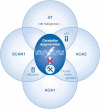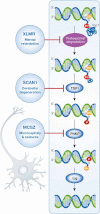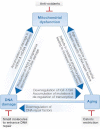To live or to die: a matter of processing damaged DNA termini in neurons
- PMID: 21246735
- PMCID: PMC3377058
- DOI: 10.1002/emmm.201000114
To live or to die: a matter of processing damaged DNA termini in neurons
Abstract
Defects in the repair of deoxyribonucleic acid (DNA) damage underpin several hereditary neurological diseases in humans. Of the different activities that repair chromosomal DNA breaks, defects in resolving damaged DNA termini are among the most common causes of neuronal cell death. Here, the molecular mechanisms of some of the DNA end processing activities are reviewed and the association with human neurodegenerative disease is discussed.
Copyright © 2011 EMBO Molecular Medicine.
Figures



References
-
- Aamann MD, Sorensen MM, Hvitby C, Berquist BR, Muftuoglu M, Tian J, de Souza-Pinto NC, Scheibye-Knudsen M, Wilson DM, III, Stevnsner T, et al. Cockayne syndrome group B protein promotes mitochondrial DNA stability by supporting the DNA repair association with the mitochondrial membrane. FASEB J. 2010;24:2334–2346. - PMC - PubMed
-
- Ahel I, Rass U, El-Khamisy SF, Katyal S, Clements PM, McKinnon PJ, Caldecott KW, West SC. The neurodegenerative disease protein aprataxin resolves abortive DNA ligation intermediates. Nature. 2006;443:713–716. - PubMed
-
- Audebert M, Salles B, Calsou P. Involvement of poly(ADP-ribose) polymerase-1 and XRCC1/DNA ligase III in an alternative route for DNA double-strand breaks rejoining. J Biol Chem. 2004;279:55117–55126. - PubMed
-
- Banerjee B, Roy A, Sen N, Majumder HK. A tyrosyl DNA phosphodiesterase 1 from kinetoplastid parasite Leishmania donovani (LdTdp1) capable of removing topo I-DNA covalent complexes. Mol Microbiol. 2010;78:119–137. - PubMed

